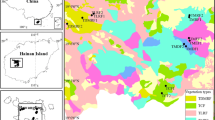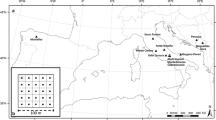Abstract
Forest biogeochemistry is strongly determined by the interaction between the tree community and the topsoil. Functional strategies of tree species are coupled to specific chemical leaf traits, and thus also to litter composition, which affects mineral soil characteristics. The limited understanding on this interaction is mainly based on shorter-term common garden experiments in temperate forest, and needs to be extended to other forest types and climates if we want to understand the universality of this linkage. In particular, for highly diverse tropical forests, our understanding of this interaction remains limited. Using an old experimental plantation within the central Congo basin, we examined the relationship between leaf and litter chemical composition and topsoil properties. Canopy, litter and topsoil characteristics were measured and we determined how the community-level leaf and litter chemical composition altered the topsoil carbon, major plant nutrients and exchangeable cation concentration, acidity and pH over the last eight decades. We found that functional composition strongly affected topsoil pH. In turn, topsoil pH strongly determined the soil total carbon and available phosphorus, total nitrogen and exchangeable potassium. Our results indicate that, as observed in temperate common garden experiments, trees alter chemical topsoil properties primarily through soil acidification, differently induced by functional composition of the tree community. The strong link between this community-level composition and topsoil characteristics, on a highly representative soil type for the tropics, improves our understanding of tropical forests biogeochemistry.

Similar content being viewed by others
References
Bauters M, Ampoorter E, Huygens D, Kearsley E, De Haulleville T, Sellan G, Verbeeck H, Boeckx P, Verheyen K. 2015. Functional identity explains carbon sequestration in a 77-year-old experimental tropical plantation. Ecosphere 6:1–11.
Bauters M, Mapenzi N, Kearsley E, Vanlauwe B, Boeckx P. 2016. Facultative nitrogen fixation by legumes in the central Congo basin is downregulated during late successional stages. Biotropica 48:281–4.
Binkley D, Giardina C. 1998. Why do tree species affect soils? The warp and woof of tree-soil interactions. Biogeochemistry 42:89–106.
Bonnier C. 1957. Symbiose Rhizobium-Légumineuses en région équatoriale. Publications de l’Institut National pour l'étude Agronomique du Congo Belge 72.
Chorover J, Sposito G. 1995. Dissolution behavior of kaolinitic tropical soils. Geochim Cosmochim Acta 59:3109–21.
Cornelissen JHC, Quested HM, Van Logtestijn RSP, Pérez-Harguindeguy N, Gwynn-Jones D, Díaz S, Callaghan TV, Press MC, Aerts R. 2006. Foliar pH as a new plant trait: can it explain variation in foliar chemistry and carbon cycling processes among subarctic plant species and types? Oecologia 147:315–26.
Dauer JM, Chorover J, Chadwick OA, Oleksyn J, Tjoelker MG, Hobbie SE, Reich PB, Eissenstat DM. 2007. Controls over leaf and litter calcium concentrations among temperate trees. Biogeochemistry 86:175–87.
Dawud SM, Raulund-Rasmussen K, Domisch T, Finér L, Jaroszewicz B, Vesterdal L. 2016. Is tree species diversity or species identity the more important driver of soil carbon stocks, C/N ratio, and pH? Ecosystems 19(4):645–60.
Díaz S, Kattge J, Cornelissen JHC, Wright IJ, Lavorel S, Dray S, Reu B, Kleyer M, Wirth C, Prentice IC, Garnier E, Bönisch G, Westoby M, Poorter H, Reich PB, Moles AT, Dickie J, Gillison AN, Zanne AE, Pierce S, Shipley B, Kirkup D, Casanoves F, Joswig JS, Günther A, Falczuk V, Rüger N, Mahecha MD, Gorné LD. 2015. The global spectrum of plant form and function. Nature 529:1–17.
Finzi AC, Van Breemen N, Canham CD. 1998a. Canopy tree–soil interactions within temperate forests: species effects on soil carbon and nitrogen. Ecol Appl 8:440–6.
Finzi AC, Van Breemen N, Canham CD, Applications SE, May N. 1998b. Canopy tree–soil interactions within temperate forests: species effects on soil carbon and nitrogen. Ecol Appl 8:440–6.
Finzi AC, Canham CD, Van Breemen N. 1998c. Canopy tree soil interactions within temperate forests: species effects on pH and cations. Ecol Appl 8:447–54.
Fisher RF. 1995. Amelioration of degraded rain forest soils by plantations of native trees. Soil Sci Soc Am J 59:544–9.
Freschet GT, Aerts R, Cornelissen JHC. 2012. A plant economics spectrum of litter decomposability. Funct Ecol 26:56–65.
Gruba P, Mulder J, Brozek S. 2013. Modelling the pH dependency of dissolved calcium and aluminium in O, A and B horizons of acid forest soils. Geoderma 206:85–91.
Gu B, Schmitt J, Chen Z, Liang L, McCarthy JF. 1994. Adsorption and desorption of natural organic matter on iron oxide: mechanisms and models. Environ Sci Technol 28:38–46.
Hobbie SE, Ogdahl M, Chorover J, Chadwick O, Chadwick OA, Oleksyn J, Zytkowiak R, Reich PB. 2007. Tree species effects on soil organic matter dynamics: the role of soil cation composition. Ecosystems 10:999–1018.
Jobbágy EG, Jackson RB. 2003. Patterns and mechanisms of soil acidification in the conversion of grasslands to forests. Biogeochemistry 64:205–29.
John R, Dalling JW, Harms KE, Yavitt JB, Stallard RF, Mirabello M, Hubbell SP, Valencia R, Navarrete H, Vallejo M, Foster RB. 2007. Soil nutrients influence spatial distributions of tropical tree species. Proc Natl Acad Sci 104(3):864–9.
Johnson AH, Frizano J, Vann DR. 2003. Biogeochemical implications of labile phosphorus in forest soils determined by the Hedley fractionation procedure. Oecologia 135:487–99.
Kauffman S, Sombroek W, Mantel S. 1998. Soils of rainforests: characterization and major constraints of dominant forest soils in the humid tropics. In: Schulte A, Ruhiyat D, Eds. Soils of tropical forest ecosystems. Heidelberg: Springer. p 9–20.
Lajtha K, Driscoll CT, Jarrell WM, Elliott ET. 1999. Soil phosphorus: characterization and total element analysis. Stand Soil Methods Long Term Ecol Res, pp 115–43.
Von Lützow M, Kögel-Knabner I, Ekschmitt K, Matzner E, Guggenberger G, Marschner B, Flessa H. 2006. Stabilization of organic matter in temperate soils: mechanisms and their relevance under different soil conditions—a review. Eur J Soil Sci 57:426–45.
Malhi Y, Phillips OL, Lloyd J, Baker T, Wright J, Almeida S, Arroyo L, Frederiksen T, Grace J, Higuchi N, Killeen T, Laurance WF, Leaño C, Lewis S, Meir P, Monteagudo A, Neill D, Núñez Vargas P, Panfil SN, Patiño S, Pitman N, Quesada CA, Rudas-Ll A, Salomão R, Saleska S, Silva N, Silveira M, Sombroek WG, Valencia R, Vásquez Martínez R, Vieira ICG, Vinceti B. 2002. An international network to monitor the structure, composition and dynamics of Amazonian forests (RAINFOR). J Veg Sci 13:439.
Matson PA, McDowell WH, Townsend AR, Vitousek PM. 1999. The globalization of N deposition: ecosystem consequences in tropical environments. Biogeochemistry 46:67–83.
Mueller KE, Eissenstat DM, Hobbie SE, Oleksyn J, Jagodzinski AM, Reich PB, Chadwick OA, Chorover J. 2012. Tree species effects on coupled cycles of carbon, nitrogen, and acidity in mineral soils at a common garden experiment. Biogeochemistry 111:601–14.
Mulder J, De Wit HA, Boonen HWJ, Bakken LR. 2001. Increased levels of aluminium in forest soils: effects on the stores of soil organic carbon. Water Air Soil Pollut 130:160.
Peel BL, Finlayson BL, McMahon TA. 2007. Updated world map of the Koppen-Geiger climate classification. Hydrol Earth Syst Sci 11:1633–44.
Quesada CA, Phillips OL, Schwarz M, Czimczik CI, Baker TR, Patiño S, Fyllas NM, Hodnett MG, Herrera R, Almeida S, Alvarez Dávila E, Arneth A, Arroyo L, Chao KJ, Dezzeo N, Erwin T, di Fiore A, Higuchi N, Honorio Coronado E, Jimenez EM, Killeen T, Lezama AT, Lloyd G, López-González G, Luizão FJ, Malhi Y, Monteagudo A, Neill DA, Núñez Vargas P, Paiva R, Peacock J, Peñuela MC, Peña Cruz A, Pitman N, Priante Filho N, Prieto A, Ramírez H, Rudas A, Salomão R, Santos AJB, Schmerler J, Silva N, Silveira M, Vásquez R, Vieira I, Terborgh J, Lloyd J. 2012. Basin-wide variations in Amazon forest structure and function are mediated by both soils and climate. Biogeosciences 9:2203–46.
R Development Core Team. 2015. R: A language and environment for statistical computing. URL: http://www.r-project.org.
Van Ranst E, Baert G, Ngongo M, Mafuka P. 2010. Carte pédologique de Yangambi, planchette 2: Yangambi, échelle 1:50.000. UGent, Hogent, UNILU, UNIKIN.
Van Ranst E, Verloo M, Demeyer A, Pauwels J. 1999. Manual for the soil chemistry and fertility laboratory. Ghent, Belgium: University of Ghent.
Reich PB, Oleksyn J, Modrzynski J, Mrozinski P, Hobbie SE, Eissenstat DM, Chorover J, Chadwick OA, Hale CM, Tjoelker MG. 2005. Linking litter calcium, earthworms and soil properties: a common garden test with 14 tree species. Ecol Lett 8:811–18.
Russell AE, Raich JW, Valverde-Barrantes OJ, Fisher RF. 2007. Tree species effects on soil properties in experimental plantations in tropical moist forest. Soil Sci Soc Am J 71:1389.
Ryan J, Estefan G, Rashid A. 2001. Soil and plant analysis laboratory manual. 2nd edn. Aleppo: ICARDA.
Saggar S, Hedley MJ, White RE. 1990. A simplified resin membrane technique for extracting phosphorus from soils. Fertil Res 24:173–80.
Schmidt MWI, Torn MS, Abiven S, Dittmar T, Guggenberger G, Janssens IA, Kleber M, Kögel-Knabner I, Lehmann J, Manning DAC, Nannipieri P, Rasse DP, Weiner S, Trumbore SE. 2011. Persistence of soil organic matter as an ecosystem property. Nature 478:49–56.
De Schrijver A, De Frenne P, Staelens J, Verstraeten G, Muys B, Vesterdal L, Wuyts K, van Nevel L, Schelfhout S, De Neve S, Verheyen K. 2012. Tree species traits cause divergence in soil acidification during four decades of postagricultural forest development. Glob Chang Biol 18:1127–40.
Sollins P. 1998. Factors influencing species composition in tropical lowland rain forest: does soil matter? Ecology 79:23–30.
Stanley WG, Montagnini F. 1999. Biomass and nutrient accumulation in pure and mixed plantations of indigenous tree species grown on poor soils in the humid tropics of Costa Rica. For Ecol Manag 113:91–103.
Toledo M, Peña-Claros M, Bongers F, Alarcón A, Balcázar J, Chuviña J, Leaño C, Licona JC, Poorter L. 2012. Distribution patterns of tropical woody species in response to climatic and edaphic gradients. J Ecol 100:253–63.
USDA. 1999. Soil taxonomy, a basic system of soil classification for making and interpreting soil surveys.
Valverde-Barrantes OJ, Smemo KA, Blackwood CB. 2015. Fine root morphology is phylogenetically structured, but nitrogen is related to the plant economics spectrum in temperate trees. Funct Ecol 29:796–807.
Vesterdal L, Clarke N, Sigurdsson BD, Gundersen P. 2013. Do tree species influence soil carbon stocks in temperate and boreal forests? For Ecol Manag 309:4–18.
Vesterdal L, Schmidt IK, Callesen I, Nilsson LO, Gundersen P. 2008. Carbon and nitrogen in forest floor and mineral soil under six common European tree species. For Ecol Manag 255:35–48.
Wright IJ, Reich PB, Westoby M, Ackerly DD, Baruch Z, Bongers F, Cavender-bares J, Chapin T, Cornelissen JHC, Diemer M, Flexas J, Garnier E, Groom PK, Gulias J. 2004. The worldwide leaf economics spectrum. Nature 12:821–7.
Xu JM, Tang C, Chen ZL. 2006. The role of plant residues in pH change of acid soils differing in initial pH. Soil Biol Biochem 38:709–19.
Zinke PJ. 1962. The pattern of influence of individual forest trees on soil properties. Ecology 43:130–3.
Zuur AF, Ieno EN, Elphick CS. 2010. A protocol for data exploration to avoid common statistical problems. Methods Ecol Evolut 1:3–14.
Acknowledgements
This research is part of the COBIMFO project, funded by the Belgian Science Policy Office (BELSPO). Marijn Bauters holds a VLADOC grant from the Flemish Interuniversity Cooperation (VLIR-UOS). The authors thank the people from the INERA (Institut National pour l’Etude et la Recherche Agronomique), for their intensive help with the inventory and the species identification, as well as all the people from the University of Kisangani (UNIKIS) who have also contributed to this publication.
Author information
Authors and Affiliations
Corresponding author
Additional information
Author contributions
M. B. collected and analysed the data, and wrote the paper, under the supervision of P. B., H. V., K. V. and E. A., S. D., G. B.; P. V. analysed soil samples and contributed to the data analysis.
Electronic supplementary material
Below is the link to the electronic supplementary material.
Rights and permissions
About this article
Cite this article
Bauters, M., Verbeeck, H., Doetterl, S. et al. Functional Composition of Tree Communities Changed Topsoil Properties in an Old Experimental Tropical Plantation. Ecosystems 20, 861–871 (2017). https://doi.org/10.1007/s10021-016-0081-0
Received:
Accepted:
Published:
Issue Date:
DOI: https://doi.org/10.1007/s10021-016-0081-0




